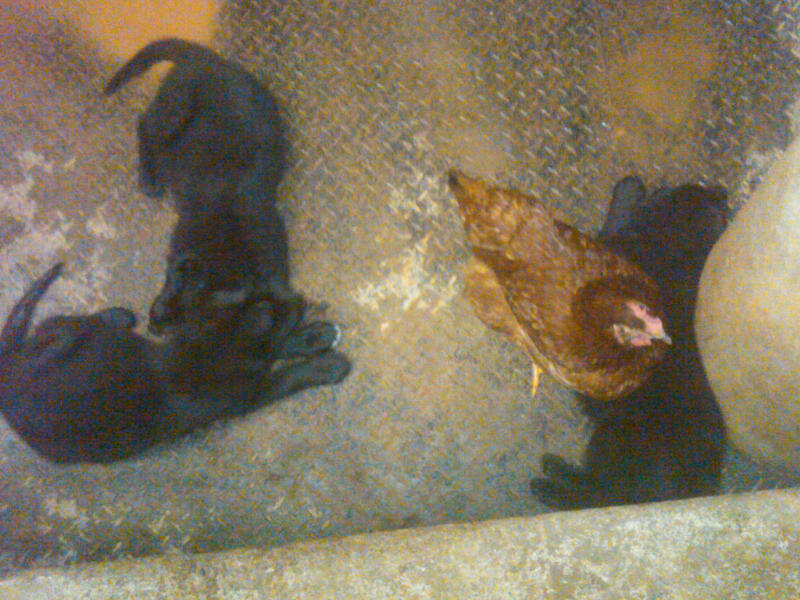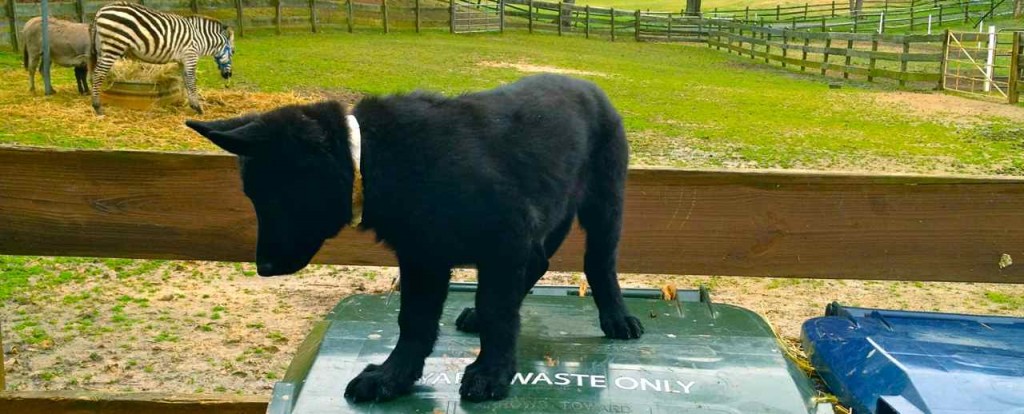Imprinting and Development
The following picture was taken of the 4 males with the most drive with a chicken in a horse stall. In 5 minutes, the chicken was relaxing with them, with her head on the back of one of the puppies. These are very well balanced dogs…but then again, they are a 2-3 breeding and I would expect nothing less. Someone asked about the pictures on our header page with the puppy on a waste container (has a zebra in the background) and wanted to know why we would want to put the dog on top of the waste container. It was to help the dog become more confident and not fear being up in the air at an early age. It’s all about early imprinting. Read more below to get more information on the importance of imprinting:
Breeders Guide To Imprinting And Critical Periods — Presentation Transcript
Breeder’s Guide to Raising Superstar Dogs – Speech by Lorraine Gaudio, CPDT, Book by Jerry Hope, CDBC
Benefits:
Produce puppies that are safer in society. Reduce puppy buyers calling with reports of puppies with fear aggression or a bite history. Help build a stronger breeders reputation & increase referrals. Preserve a good breed reputation. Take a responsibility for all the puppies you add the community. Produce emotionally stable puppies. Prevent your puppies from the shelter and re-homing (First home is a forever home). Foundation work is life lasting so it is easier to have rehabilitation and recovery of fear (repo dogs). Puppy owners have a responsibility to their puppy and their community. Reduce the work on the owners can increase the value of your puppies verses your competitor.
Puppies enter new homes:
At 10-12 weeks old, should be house trained. Confident around people, dogs, other animals. Already having taught basic cues. Have a easy to follow plan for your puppy owners to continue.
The research:
In 1965 John Paul Scott & John L. Fuller wrote “Dog Behavior: The Genetic Basic and Genetics and Social Behavior of the Dog.” Over 40 year old research is now formatted and easy to understand. Multiple Animal Behaviorists and Veterinarians working together with breeders Jerry Hope, CDBC; Dr. Ian Dunbar; Tammie King, Bsc (Hons); Lynn Hoover; Martin Deeley, Nicole Wilde, CPDT; Brenda Aloff; Konrad Lorenz to name just a few
What is Socialization?
Continuing life long process where individual acquires personal identity, learns norms, values, behavior, and social skills. How is it done best? Fear is not genetic. There is a reason for stress. Exposure, recovery of conflict and being allowed to be curious. Stay in comfort level, go slow. NEVER FORCE something the puppy is fearful of, upon the puppy. Think about what does fear look like?
Imprinting:
Exposure in small doses to many different things of practical and social character during critical development stages. It is for life! Whether you do a program or not, imprinting will happen. Sometimes imprinting doesn’t happen on what we intended it to be on. ALL experienced including vet visits must be enjoyable. How does the dog see this situation? Imprinting is used extensively be horse breeders with great success! We are lucky to have a bigger window. Imprinting on puppies is between -3 weeks and 10+ weeks old. Whelping box design can even have an effect on imprinting.
Case study:
A female dog has a great pedigree that contains dogs with super temperaments. She is nervous and fearful because of the way she was raised. How does this effect imprinting?
–The chances are high that the pups will learn from their mother that fearful and nervous behavior is normal. Correct her behavior issues before breeding!
Critical Periods:
Mental growth periods are where specific learning happens from the puppy’s environment and experiences where optimum retention will take place. Timing is everything! Exposing too young can do damage where if only a few weeks older, it would have had a more positive effect. Same goes for waiting to long. You missed your window.
Pre-natal:
Make sure the bitch is healthy before breeding. Keep bitch relaxed and calm during pregnancy. Good Diet. Fresh water. Moderate exercise. Give her the attention and affection if she become clingy.
Neo-natal:
Birth to 12 days“Bio-Sensor” proven to strengthen immune system, create stronger heartbeats and promote more rapid recovery to stress in it’s adult life. Introduce involuntary systems to changing positions starting at 3 days old (if dewclaws were removed at 2 days start on 5). Stop when pups eyes start to open. Five exercises done 1 x day at the same time you weight the pup ,never lasting more the 5 seconds (start at 3 seconds). Tactile Stimulation with a q-tip. Head up, head down, turn on their back. Thermal StimulationWeigh and return to mom for comfort.
Transitional Period:
This is between 13 days to 20 days old. Eyes are open but will not be fully functional until 9-10 weeks. Ears open and will have full hearing by 20 -22 days old. Increase brain activity with noise and light. For about 2 minutes: Expose to soft noises and low level light changes with changing tempo (classical music on TV). Increase levels as pups begin to move around more. GO SLOW but use Thunder tapes, play base music. Make startling sound while pups are all cuddled and sleeping. What is a noisy home with kids like? Crying baby’s, gun shots . . . http://www.legacycanine.com/store/index.html. Weaning puppies are touched while eating their gruel. Touch food to mouths and hand feed puppies a little.
Socialization Period:
This is between 3 weeks to 14 weeks old. All of the following behaviors will be continued into new home and will slowly become more advanced. Teach bite inhibition (most important skill). Start with introducing other animals like cat(s), bird(s), KNOW THE TEMPERMENT and MEDICAL HISTORY of the other animals. Don’t skip this very important step. Find animals safe and healthy. Protective mom’s are put away securely. Recall as soon at they are on their legs. Allow them to explore a new safe area. Add interesting items in the area each day (pull out things from the garage and closet). At 4 wks, start taking then out to potty (every meal, play, upon waking up).
At 5 wks, start introducing one-two new person(s) every day for ten minutes. (Clean hands. Everyone should remove shoes at the front door.) 100 people by 14 weeks (race, age clothes, smell). Teach sit, down, stand (1-2 min). Teeth, toes, testicles inspected. Pry drive play (flirt pole), show stacking, agility poles and tunnels ball on the wall, retrieve at 7 wk , bodies of water (shallow to start). Tug for bite inhibition and out with rules. At 8wks take training on the road. Collar and lead drag, play follow me.
Awareness Period:
This begins at 21 to 28 Days old. Sudden sounds .DO NOT MOVE LITTER LOCATION. Keep environment stable during this period.
First impact Period:
Occurs at 8 to 11 weeks. First fear. The worst time to go to a new home and often it’s time for the first vet visit. A long drive can make the puppy hate car rides. Locked in a crate for the first time all night crying for mommy is damaging for life! Fear issues can be traced back to this period, not because the experience itself but because it all happened during this period. IF puppies must go during this period, the family setting needs to be secure and non-threatening, non-stressful. They are better suited for an educated pet owner.
Seniority Classification Period:
This occurs at 13 to 16 weeks old. In recovery of fear period. Teething: offer chews. Find themselves as individuals, grow, personality develops. Must remove from litter or they will bond with each other. Some puppies will become bullies and other will become submissive. Puppies should have separate time away from other dogs and have one on one time with people. Space grows personalities free from the influence of litter mates. Work on resource guarding. Positive training grows confidence.
Flight Instinct:
This period is from 4 months to 8 months of age. Puppies become brave and investigative and it’s good to allow them to do so and build upon this. Don’t ruin your recall. Marking and house training may slip so watch them closely. Still teething so reinforce chewing behaviors on the correct items.
Second Impact Period:
This occurs at 6 to 15 months of age. Fear suddenly, even a well socialized pup. Do not force dog to cope with fear (Flooding), sudden rebelliousness, becomes disobedient, hardheaded, and fearful. How this is handled may determine how long the puppy stays with the family and how the puppy sees people for the rest of their life.
Maturity:
Age varies by breed (small dogs sooner, giant breeds later then 1 ½ years old. (German Shepherds won’t mature until at least 2 years of age). Monitor mature dogs of the same sex. One day a friendship may turn into a challenge, and fights will result.
What can we change:
Don’t prohibit people from coming to visit the puppies. Puppies should stay with the litter till minimum of 8 weeks, preferable until 10 weeks old but no later then 12 weeks old. Expose the pups to light, noise, strangers of all species and ages, and the hustle and bustle of everyday life. Be responsible for the outcome of the puppy.
Testing:
Aptitude testing is done around 7 to 8 weeks old and this is also a great time to evaluate structure. Novel stimuli, thinking puzzle, handling test results in should be given to puppy owners. Temperament testing is done around 18 months of age.
Record your choice of puppy imprinting in detail. Get a record book to be kept as a complete journal of the daily activities. You do not need to do all or even any of the ideas presented. But doing some of them at the very least will help your puppy imprint correctly and begin development on the right path.
We have the best all black German Shepherd lines available anywhere in the world. We have various age black German Shepherd puppies for sale that are available, either as is, or with additional training in obedience or both obedience and protection. Click here for all of our Black German Shepherd Puppies For Sale.



Recent Comments